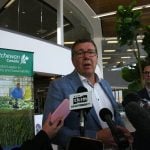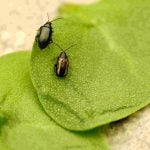Prairie crop production is being more intensively managed than ever before. Tight economic margins, developments in crop genetics and pushing crop rotations are factors, as is the influence young educated farmers moving into decision-making roles. This, along with the slow reduction of input costs due to increased competition and products coming off patent has made the application of fungicides much more mainstream.
In the past, fungicides were often thought to be reserved for highly intensive farm management in Europe and select areas of the Prairies. This has changed, partly because there are more acres of chickpeas, lentils and other specialty crops that require fungicide applications, and partly because it increasingly makes economic sense for all types of cereal, pulse and oilseed crops.
Read Also

Research studies fruit-forage intercropping
Researchers are looking at Prairie farmers’ options for intercropping annual or perennial crops with shelterbelts composed of berry bushes and tree species such as seabuckthorn and buffalo berry, to boost biodiversity and returns.
DISEASE PRESSURE RISING
When farmers try to determine the level of disease pathogens that may be of concern for 2011, there are a couple of factors to consider. Weather has the largest impact, with increased moisture, humidity, and temperature favouring disease outbreaks, as well as crop rotations and past disease infestation levels. Saskatchewan Agriculture’s annual disease survey shows an upwardstrend for most diseases, particularly fusarium head blight and sclerotinia in canola. The following table shows the 2010 survey results.
The last two to three years has not only seen a higher incidence of disease but also infestations in areas that usually don’t have major infestations. And last year’s wet weather has set us up for increased disease problems in 2011.
With increased disease levels come increased fears about fungicide resistance. Farmers are well aware of herbicide resistance.
Battling Group 2 resistant kochia or Group 1 and 2 resistant wild oats is definitely a management concern for many, however very few farmers seem to be concerned about resistance to commonly used fungicides. They should be, as there already are documented occurrences of ascochyta resistance in chickpeas to the strobilurin family of fungicides.
This is an issue that farmers need to be aware of and they must manage fungicides wisely in order to ensure their continuing effectiveness. Many manufacturers have stewardship programs to maintain fungicide effectiveness, but responsibility falls on all farmers to implement them.
KNOW THE RESISTANCE RISK
All fungicides are rated for resistance risk. These ratings are based on:
1 Product group.Products are classed according to their active ingredients. In Western Canada, there are four main groups with the vast majority of products falling into only three of these. This small range makes it difficult, even with good rotations, to avoid overuse.
2) Multi-site vs. single-site Activity.Active ingredients attack disease pathogens at either one or many different biological sites. Pathogens are more likely to develop resistance if the product only attacks a single site.
3) Multiple modes of action. Using a product with two different modes of action reduces the likelihood of resistance developing, but doesn’t eliminate it. Overusing these products in a growing season or using them in the same field season after season will lead to a gradual loss in effectiveness due to resistant pathogens.
It is important to know how the products used on your farm rate in terms of risk for resistance development. Those with a high risk rating must be used selectively and, whenever feasible, a product with a lower rating should be considered (see table 1). For example, strobilurin products (Headline, Quadris) are often reserved for pulse crop diseases and can also be effective on cereal crops. However it may be wiser to use a fungicide from another group with a lower risk rating on cereal acres. Using the same chemical family repeatedly on all crop types will set you up for an increased rate of resistance.
You also need to consider what your neighbours are doing. Diseases spread through environmental (wind) or mechanical (on vehicle tires or pant legs) factors and what may start as your neighbour’s problem can quickly become yours. Once disease resistance occurs, it too can quickly spread from field to field. This was demonstrated in how quickly chickpeas developed ascochyta resistance to strobilurin fungicides.
We’ve all questioned whether disease levels in a certain field warrant using a fungicide, and unfortunately there is a lack of good prediction tools available for determining whether or not spraying is justified. Many times we are left trying to estimate the yield potential and, along with the weather forecast, make a decision at critical stages in crop development. It’s often a gut decision, not a scientific one, even when based on experience.
Given the moisture and disease levels from last year, disease pressure should be top of farmers’ minds for 2011. We may see more disease both in areas which have traditionally suffered outbreaks and those which haven’t. Proper use of fungicides will be critical in the coming year, and we need to employ good stewardship to reduce the development of resistance on our farms.
BobbieBratrudfarmswithherhusbandMark nearWeyburn,Sask.TheyalsorunBratrud AgAdvisoryServices( www.bratrudag.ca)
———
11 11
RISK RATING OF FUNGICIDES RATING PRODUCT
GROUP M
ACTIVE INGREDIENT CHLOROTHALONIL
COMMENTS MULTI-SITE ACTIVITY
Low
Medium
High
Bravo
Tilt (Bumper)
Folicur
Proline
Stratego
Caramba
Quilt
Lance
Headline Duo
Headline Quadris
3
3
3
3,11
3
3,11
7
3,7
propiconazole
tebuconazole
prothioconazole
propiconazole, trifloxystrobin
metconazole
propiconazole, azoxystrobin
boscalid
pyraclostrobin, boscalid
pyroclostrobin azoxystrobin Multi-mode of action
Multi-mode of action
Multi-mode of action
Limit use to 2x/year Limit use to 2x/year
———
Ascochyta Complex
TABLE 1. PREVALENCE OF PLANT DISEASES IN PEAS AND CANOLA IN SASKATCHEWAN IN 2010 (PER CENT OF CROPS SURVEYED THAT SHOWED AT LEAST TRACE LEVELS OF CORRESPONDING DISEASE SYMPTOMS)
Region (number of crops
surveyed) P = pea
L = lentil C = canola
Northwest (13 P, 38 C)
Northeast (3 P, 52 C)
West-central (11 P, 16 L,
35 C) East-central (11 P, 104 C) Southwest (41 P, 13 L,
10 C)
Southeast (6 P, 21 C)
Total Surveyed (85 P, 29 L, 260 C)
Pea Diseases: Ascochyta pisi(AP),
mycosphaerella blight(MB), Septoria pisi(SP), sclerotinia white mould(WM)
0
0
9
0
44
17
0
MB
100
100
100
100
98
100
99
SP
0
0
0
0
85
33
47
WM
50
67
27
82
10
0
27
Lentil Diseases: anthracnose(AN), ascochyta blight(AB), stemphylium blight(SB), botrytis grey mould(GM), sclerotinia white mould(WM)
Canola Diseases
AN AB SB GM WM Blackleg Sclerotinia
56
46
52
31
15
24
88
77
83
56
23
41
69
46
59
61
48
57
50
70
62
54
92
90
94
91
80
95
92














